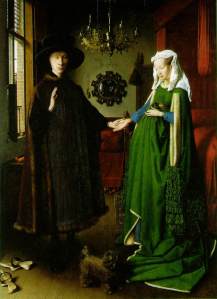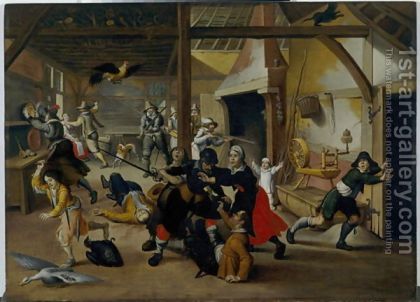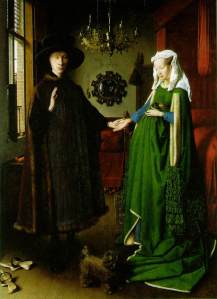Baroque Blog
February 23, 2010
SOILDERS PLUNDERING A FARM DURING THE THIRTY YEARS WAR
Sebastian Vrancx 1620
I chose this painting because it clearly depicts events from the Baroque time. The Baroque period was heavily punctuated by the Thirty Years war. The carnage and genocide influenced every single person in Europe artists included. If your country was not actively fighting at the moment, you were paying exorbitant taxes so your ruler could give monetary aid to countries that were fighting.
The low countries where Vrancx was from were heavily involved in the intrigue and combat of the time period and it is no surprise that Vrancx main subject was warfare. Vrancx worked with Ruben and Brueghal the Elder as contemporary and collaborators.
Vrancx does not fight into either of the Poussinistes or Rubenistes school of art. Vrancx drafted most of his work which heavily depends on line (Poussinistes style) but he also occasionally focused on color which does not exclude him from Rubenistes styling. Many of Vrancx paintings were rather drab. Four landscapes for four seasons is an example (http://www.artcyclopedia.com/artists/vrancx_bastiaen.html). I believe that Vrancx depended more on line then color.
The Subject matter is fitting for the time period and is why I choose the painting. I feel this painting represents the schizophrenic culture of Europe. Soldiers stood in orderly lines and fought with very elaborate codes of conduct (rules of chivalry). It was unfitting and an utter disgrace for a military unit to not perform to the moral standard during battle. However for the remaining time, there were no rules and no morality that applied. The man facing you in battle with full formality and dignity may have just raped your wife and burnt your home. Soldiers were expected to loot and plunder for food. Military organization had been forgotten and armies were formed and deployed without food, shelter or extra clothing. It was cheaper to take from the locals and far easier then shipping food across the continent. http://en.wikipedia.org/wiki/Thirty_Years’_War Entire populations were eradicated Wurttemberg lost 75% of its estimated 1 million inhabitants. The German region lost (by lost I mean eradicated and razed to the ground) 2000 castles, 18,000 villages and 1500 towns to just the Swedes.
This painting to me has the same symbolism that a painting of the holocaust or the killing grounds of Kosovo would. The military uniforms are different, but the events are all too similar.
Northern renaissance
February 13, 2010
 I chose the painting Arnolfini Portrait by Van Eyck because of the mystery and controversy surrounding it. Van Eyck was born somewhere in Flanders and the exact year and location are unknown. During his lifetime the low countries including Flanders were in fiefdom to the Duchy of Burgundy. The Duke of Burgundy Phillip the good was Van Eyck’s patron for the majority of Van Eyck’s career. The Duchy of Burgundy surpassed in wealth, maritime and martial power, trade and wealth most of Europe. This opulence allowed patronage and support of the arts similar to the much wealthier Italian states. While not many of Van Eyck’s works survive, the Arnolfini Portrait may be the most controversial. The primary controversy centres around who is depicted by the painting. Two Arnolfini family members are thought to be the subject of the painting. Giovanni di Nicolao Arnolfini is widely accepted to be the subject. However if he is the subject, his wife was dead long before 1434 the year that Van Eyck inscribed above the mirror. So that leaves three options. First is that Giovanni is not the Arnolfini depicted. Second this is a funerary/memorial portrait commissioned by a lovelorn husband. Third is that it is a wedding portrait of Giovanni’s second wife. Historians have narrowed down the Arnolfini based on ducal court records, birth and death records, and trade records. I will side with these historians because they have looked at numerous records that I have no access to, and their findings have been disputed and critiqued by other historians. The second option is that it is a funerary painting. However the wife was not buried in 1434, she would not have been present for sittings for some time before the written date. Either the painting took many years, or Van Eyck had the worlds greatest memory. The idea that it is a forlorn husband is a very cultural-centric idea. During the 1400’s people died like insects, marriages were arranged even in the non royal merchant class that Arnolfini belonged to. Attachments were not quite the same as today. Yes, Arnolfini may have deeply loved his wife, but romantic notions are often created to gloss over uncouth realities. This is why I support the third option-marriage portrait to another woman. Clear defined marriage was critical to trade and wealth of merchant and noble families alike. Arnolfini would need to prove he was married to the women to access her dowry and family bank accounts. Any offspring would need to prove that they were legitimate to inherit the family wealth. This is even more critical in a second marriage. The only guarantees for the wealthy were that plague would decimate your lands and your children and family would destroy each other after your death. Flemish business men were among the most ruthless in European history. The determination of a legitimate Arnolfini heir had implications that would affect every single day that Arnolfini did business. This painting if used as a marriage portrait would prove its value daily. One must look at the possibilities with the same pragmatism a Flemish merchant would use. Unlike Popes and Kings, a businessman would not invest in the expense of a painting if he would not get a return. (AlthI chose the painting Arnolfini Portrait by Van Eyck because of the mystery and controversy surrounding it. Van Eyck was born somewhere in Flanders and the exact year and location are unknown. During his lifetime the low countries including Flanders were in fiefdom to the Duchy of Burgundy. The Duke of Burgundy Phillip the good was Van Eyck’s patron for the majority of Van Eyck’s career. The Duchy of Burgundy surpassed in wealth, maritime and martial power, trade and wealth most of Europe. This opulence allowed patronage and support of the arts similar to the much wealthier Italian states. While not many of Van Eyck’s works survive, the Arnolfini Portrait may be the most controversial. The primary controversy centres around who is depicted by the painting. Two Arnolfini family members are thought to be the subject of the painting. Giovanni di Nicolao Arnolfini is widely accepted to be the subject. However if he is the subject, his wife was dead long before 1434 the year that Van Eyck inscribed above the mirror. So that leaves three options. First is that Giovanni is not the Arnolfini depicted. Second this is a funerary/memorial portrait commissioned by a lovelorn husband. Third is that it is a wedding portrait of Giovanni’s second wife. Historians have narrowed down the Arnolfini based on ducal court records, birth and death records, and trade records. I will side with these historians because they have looked at numerous records that I have no access to, and their findings have been disputed and critiqued by other historians. The second option is that it is a funerary painting. However the wife was not buried in 1434, she would not have been present for sittings for some time before the written date. Either the painting took many years, or Van Eyck had the worlds greatest memory. The idea that it is a forlorn husband is a very cultural-centric idea. During the 1400’s people died like insects, marriages were arranged even in the non royal merchant class that Arnolfini belonged to. Attachments were not quite the same as today. Yes, Arnolfini may have deeply loved his wife, but romantic notions are often created to gloss over uncouth realities. This is why I support the third option-marriage portrait to another woman. Clear defined marriage was critical to trade and wealth of merchant and noble families alike. Arnolfini would need to prove he was married to the women to access her dowry and family bank accounts. Any offspring would need to prove that they were legitimate to inherit the family wealth. This is even more critical in a second marriage. The only guarantees for the wealthy were that plague would decimate your lands and your children and family would destroy each other after your death. Flemish business men were among the most ruthless in European history. The determination of a legitimate Arnolfini heir had implications that would affect every single day that Arnolfini did business. This painting if used as a marriage portrait would prove its value daily. One must look at the possibilities with the same pragmatism a Flemish merchant would use. Unlike Popes and Kings, a businessman would not invest in the expense of a painting if he would not get a return. (Although being discussed almost 600 years later could be considered a substantial return) http://www.nationalgallery.org.uk/paintings/jan-van-eyck-the-arnolfini-portrait http://en.wikipedia.org/wiki/Jan_van_Eyck ough being discussed almost 600 years later could be considered a substantial return) http://www.nationalgallery.org.uk/paintings/jan-van-eyck-the-arnolfini-portrait http://en.wikipedia.org/wiki/Jan_van_Eyck
I chose the painting Arnolfini Portrait by Van Eyck because of the mystery and controversy surrounding it. Van Eyck was born somewhere in Flanders and the exact year and location are unknown. During his lifetime the low countries including Flanders were in fiefdom to the Duchy of Burgundy. The Duke of Burgundy Phillip the good was Van Eyck’s patron for the majority of Van Eyck’s career. The Duchy of Burgundy surpassed in wealth, maritime and martial power, trade and wealth most of Europe. This opulence allowed patronage and support of the arts similar to the much wealthier Italian states. While not many of Van Eyck’s works survive, the Arnolfini Portrait may be the most controversial. The primary controversy centres around who is depicted by the painting. Two Arnolfini family members are thought to be the subject of the painting. Giovanni di Nicolao Arnolfini is widely accepted to be the subject. However if he is the subject, his wife was dead long before 1434 the year that Van Eyck inscribed above the mirror. So that leaves three options. First is that Giovanni is not the Arnolfini depicted. Second this is a funerary/memorial portrait commissioned by a lovelorn husband. Third is that it is a wedding portrait of Giovanni’s second wife. Historians have narrowed down the Arnolfini based on ducal court records, birth and death records, and trade records. I will side with these historians because they have looked at numerous records that I have no access to, and their findings have been disputed and critiqued by other historians. The second option is that it is a funerary painting. However the wife was not buried in 1434, she would not have been present for sittings for some time before the written date. Either the painting took many years, or Van Eyck had the worlds greatest memory. The idea that it is a forlorn husband is a very cultural-centric idea. During the 1400’s people died like insects, marriages were arranged even in the non royal merchant class that Arnolfini belonged to. Attachments were not quite the same as today. Yes, Arnolfini may have deeply loved his wife, but romantic notions are often created to gloss over uncouth realities. This is why I support the third option-marriage portrait to another woman. Clear defined marriage was critical to trade and wealth of merchant and noble families alike. Arnolfini would need to prove he was married to the women to access her dowry and family bank accounts. Any offspring would need to prove that they were legitimate to inherit the family wealth. This is even more critical in a second marriage. The only guarantees for the wealthy were that plague would decimate your lands and your children and family would destroy each other after your death. Flemish business men were among the most ruthless in European history. The determination of a legitimate Arnolfini heir had implications that would affect every single day that Arnolfini did business. This painting if used as a marriage portrait would prove its value daily. One must look at the possibilities with the same pragmatism a Flemish merchant would use. Unlike Popes and Kings, a businessman would not invest in the expense of a painting if he would not get a return. (AlthI chose the painting Arnolfini Portrait by Van Eyck because of the mystery and controversy surrounding it. Van Eyck was born somewhere in Flanders and the exact year and location are unknown. During his lifetime the low countries including Flanders were in fiefdom to the Duchy of Burgundy. The Duke of Burgundy Phillip the good was Van Eyck’s patron for the majority of Van Eyck’s career. The Duchy of Burgundy surpassed in wealth, maritime and martial power, trade and wealth most of Europe. This opulence allowed patronage and support of the arts similar to the much wealthier Italian states. While not many of Van Eyck’s works survive, the Arnolfini Portrait may be the most controversial. The primary controversy centres around who is depicted by the painting. Two Arnolfini family members are thought to be the subject of the painting. Giovanni di Nicolao Arnolfini is widely accepted to be the subject. However if he is the subject, his wife was dead long before 1434 the year that Van Eyck inscribed above the mirror. So that leaves three options. First is that Giovanni is not the Arnolfini depicted. Second this is a funerary/memorial portrait commissioned by a lovelorn husband. Third is that it is a wedding portrait of Giovanni’s second wife. Historians have narrowed down the Arnolfini based on ducal court records, birth and death records, and trade records. I will side with these historians because they have looked at numerous records that I have no access to, and their findings have been disputed and critiqued by other historians. The second option is that it is a funerary painting. However the wife was not buried in 1434, she would not have been present for sittings for some time before the written date. Either the painting took many years, or Van Eyck had the worlds greatest memory. The idea that it is a forlorn husband is a very cultural-centric idea. During the 1400’s people died like insects, marriages were arranged even in the non royal merchant class that Arnolfini belonged to. Attachments were not quite the same as today. Yes, Arnolfini may have deeply loved his wife, but romantic notions are often created to gloss over uncouth realities. This is why I support the third option-marriage portrait to another woman. Clear defined marriage was critical to trade and wealth of merchant and noble families alike. Arnolfini would need to prove he was married to the women to access her dowry and family bank accounts. Any offspring would need to prove that they were legitimate to inherit the family wealth. This is even more critical in a second marriage. The only guarantees for the wealthy were that plague would decimate your lands and your children and family would destroy each other after your death. Flemish business men were among the most ruthless in European history. The determination of a legitimate Arnolfini heir had implications that would affect every single day that Arnolfini did business. This painting if used as a marriage portrait would prove its value daily. One must look at the possibilities with the same pragmatism a Flemish merchant would use. Unlike Popes and Kings, a businessman would not invest in the expense of a painting if he would not get a return. (Although being discussed almost 600 years later could be considered a substantial return) http://www.nationalgallery.org.uk/paintings/jan-van-eyck-the-arnolfini-portrait http://en.wikipedia.org/wiki/Jan_van_Eyck ough being discussed almost 600 years later could be considered a substantial return) http://www.nationalgallery.org.uk/paintings/jan-van-eyck-the-arnolfini-portrait http://en.wikipedia.org/wiki/Jan_van_Eyck

